Bologna may lag slightly behind Florence and Rome when it comes to art treasures, but when it comes to food, the city is in a class of its own, rapidly gaining ground as the country’s food capital. Let’s just say it’s not called ‘la grassa’ (‘the fat one’) for nothing!
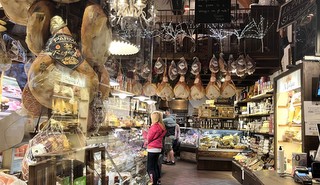
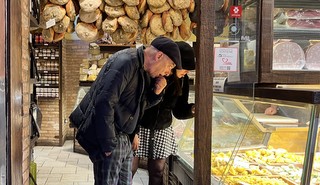
Tortellini, mortadella, prosciutto, parmigiano … the list of mouthwatering goodies that have become synonymous with the city goes on and on. Actually, several of them, such as Parma ham, parmesan cheese and balsamic vinegar originate from the neighbouring towns of Parma and Modena but they still take centre stage on any self-respecting Bolognese table. Of course, Bologna’s not just about food. If you’re looking for culture, you’ll find enough to do to easily fill a couple of days, whether visiting the main Basilica di San Petronio, the beautiful porticoed Archiginnasio di Bologna, or the Basilica di San Domenico with its early Michelangelo sculptures.
Start at the Quadrilatero
There’s only one place to kick off your gastronomic browsing – the food shops in the Quadrilatero. This tangle of narrow streets and alleyways just behind the central Piazza Maggiore is food heaven. Feast your eyes on mounds of fresh tagliatelle, pasta parcels of tortellini and plump pillowy tortelloni. Stroll past windows piled high with chunks of parmigiano, past salumerias and tiny bottegas with magnificent displays of, in May, luscious strawberries and vivid green asparagus.
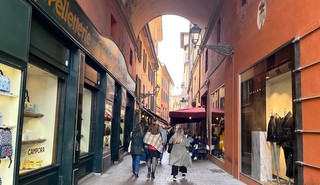
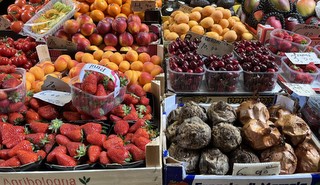
Think about timing your visit to the Quadrilatero to coincide with lunch. We loved ZeroCinquantino, a popular ‘tigelleria’ where we started our meaty journey perched on high stools, with just enough room on our table to accommodate the huge platter of cold meats, cheese and the local flat bread speciality, ‘tigelle’.
Take a hike to the Sanctuary of San Luca
Need to burn some of those calories before dinner? Set off from Via Saragozza along the world’s longest portico up to the hilltop Sanctuary of San Luca. Boasting an impressive 666 arches, the covered walkway is just under 4km long, with more than enough of a final elevation to raise your pulse. And if you happen to be there at the end of June 2024, you’ll be treated to the spectacle of the 2nd stage of the Tour de France, from Cesenatico to Bologna, as the cyclists make their ascent to the Sanctuary!
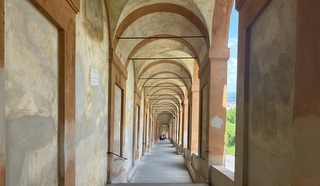
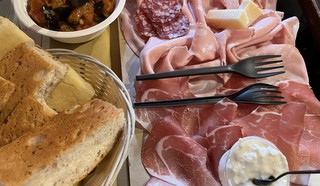
And finally, if this is your first trip to Bologna or the Emilia Romagna region, here’s a quick key to some of Bologna’s must-eat foods:
Pasta
Tortellini, smaller ring-shaped pasta parcels, are generally filled with pork loin, prosciutto, mortadella and parmesan, and traditionally served ‘in brodo’. Their bigger brother, tortelloni, are often filled with pumpkin and topped with butter and sage.
Bread
Tigelle are flat rolls made of thick round discs of soft dough that are cooked on a ‘tigella’ (iron griddle plate). Also typical of Modena, they are often filled with meat, cheese and vegetables.
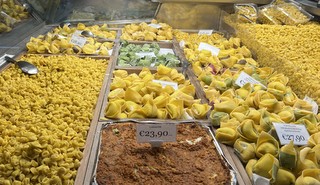
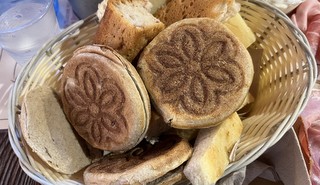
Meat
Prosciutto di Parma, from nearby Parma is used as a filling in ‘piadine’ or ‘tigelle’ while mortadella appears on every ‘tagliere’ (charcuterie board). The local mortadella is made of high quality fine ground pork, cubes of lard, black peppercorn and sometimes pistachio. Both meats are also used as pizza toppings.
Most people naturally associate Bologna with spaghetti Bolognese. In fact, in restaurants and trattoria, you will find ‘tagliatelle al ragù’ but the meat sauce is usually made of a mixture of pork and veal.
Cheese
Parmigiano is king, but you’ll also come across ‘squacquerone’, a fresh cow’s milk cheese, with a mild, sweet, milky flavour. It’s a popular filling for ‘tigelle’, and often served with charcuterie.
Other specialities of the city include ‘crescentine’, made of a dough that’s been rolled into thin discs and fried in hot oil. Also known as ‘gnocchi fritti’, they are a popular appetizer with meat platters and fresh cheeses. ‘Friggione’ is a dish comprising slow cooked onions and tomatoes, sometimes served with fresh egg pasta but also used as a side dish. Although strictly from Modena, rather than Bologna, balsamic vinegar is widely available in Bologna’s food shops and markets.
What to drink in Bologna?
Pignoletto is a DOC certified sparkling white from the hills of Emilia Romagna made from the Grechetto grape variety, ideal as an aperitif. Local red wines from the Emilia Romagna region include sparkling Lambrusco from Modena, and Sangiovese, which both go well with charcuterie and pasta.
